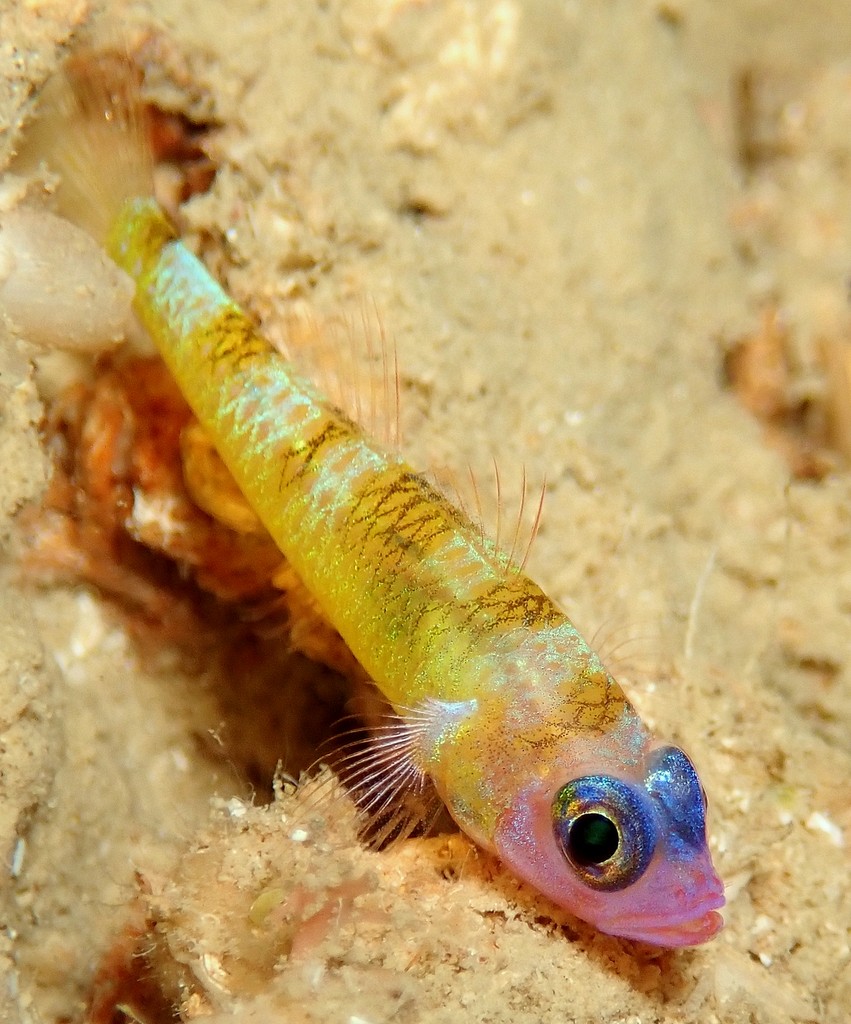TRIMMA FASCIATUM - (SUZUKI, SAKAUE & SENOU, 2012)
Picture courtesy of: Alain Daoulas
Actinopterygii (Gigaclass) > Actinopteri (Class) > Teleostei (Subclass) > Gobiiformes (Order) > Gobioidei (Suborder) > Gobiidae (Family) > Gobiinae (Subfamily) > Trimma (Genus)
Etymology
Trimma: from Greek, trimma, -atos = something crushed.
fasciatum: from Latin, fascio = I envelop with bands, swathe. Named in allusion to the yellow bands of body of the new species.
Original description: Trimma fasciatum Suzuki, Sakaue & Senou, 2012 - Type locality: Ngemlis Reef, Ngis Island, Palau, 07°08'17.0"N, 134°13'18.5"E, 30 m depth, 8 May 2009.
Distribution
Eastern Indian Ocean, western Pacific: Christmas Island (Indian Ocean) east to Palau, north to Ryukyu Islands (Japan), south to Australia and New Caledonia.
Actinopterygii (Gigaclass) > Actinopteri (Class) > Teleostei (Subclass) > Gobiiformes (Order) > Gobioidei (Suborder) > Gobiidae (Family) > Gobiinae (Subfamily) > Trimma (Genus)
Gobie pygmée à bandes jaunes, Yellow-banded pygmygoby, Dokutsu-shima-benihaze, ドウクツシマベニハゼ,
Description
Description
Dorsal spines (total): 7; Dorsal soft rays (total): 8; Anal spine: 1; Anal soft rays: 8; Pectoral fin rays: 14-16 (usually: 16); Longitudinal scales: 23-24 (Usually: 24); Vertebrae: 10 + 16 = 26. Second and third spines of first dorsal fin longest (second spine in one, third spine in one), but not elongate and filamentous, not reaching posteriorly to second dorsal-fin origin when adpressed (reaching to first segmented ray base of second dorsal fin in one juvenile paratype); First dorsal fin separate from second dorsal fin. All pectoral-fin rays unbranched; Fin not reaching posteriorly to above anal-fin origin. All pelvic-fin rays each with two terminal tips; Fifth ray 53% (48% in one; 59% in one) of fourth ray in length; Fourth ray longest, reaching posteriorly to base of third segmented ray of anal fin when adpressed (anal-fin origin in one juvenile, Fourth segmented ray base of anal fin in one). No pelvic-fin frenum. Basal membrane between innermost pelvic-fin rays about 23% of length of fifth ray Cheek with two embedded cycloid scales dorsally (absent in two). Opercle with 5 embedded cycloid scales dorsally (2 in one, absent in one juvenile). Pectoral-fin base with 3 cycloid scales in 2 vertical and 2 horizontal rows (2 scales in 1 vertical and 2 horizontal in two), preplevic area scaled in 8 longitudinal and 4 transverse rows of cycloid scales (5 longitudinal rows in one, absent in one juvenile), and anterior half of midline of belly with small cycloid scales (cycloid scales on midline in one, absent on midline in one juvenile). Nape with ctenoid scales, extending anteriorly to orbit. Other parts of body with large ctenoid scales. Gill opening extending below a vertical line just slightly posterior to the middle of the pupil (middle of pupil in one, between anterior edge and middle of eye in one). Anterior naris with a short tube; Posterior nasal opening a simple pore, 2 naris diameter from anterior naris and 9 naris diameter from eye. Interorbital groove shallow (moderate in one), postorbital groove absent. Interorbital space narrow and bony width 18% of pupil diameter (26% in one juvenile). Max. length: 2.3 cm SL. Depth range: 15 - 40 m.
Color
Pink, red, white and yellow colors faded. Head and body pale yellow semi-translucent. Scale pockets of nape and dorsal sides of body outlined with reddish brown. Scale pockets on the dorsum lack dark margins; Gill and aorta deep red; Snout, base and anterior part of pectoral fin, interspaces of yellow bands on dorsal side of body pale sky blue; Iris and interorbital space bright blue; Lacks the yellow bar below the middle of the second dorsal fin, and the bars across the nape are yellowish. Colors may fade for individuals who live in caves
Etymology
Trimma: from Greek, trimma, -atos = something crushed.
fasciatum: from Latin, fascio = I envelop with bands, swathe. Named in allusion to the yellow bands of body of the new species.
Original description: Trimma fasciatum Suzuki, Sakaue & Senou, 2012 - Type locality: Ngemlis Reef, Ngis Island, Palau, 07°08'17.0"N, 134°13'18.5"E, 30 m depth, 8 May 2009.
Distribution
Eastern Indian Ocean, western Pacific: Christmas Island (Indian Ocean) east to Palau, north to Ryukyu Islands (Japan), south to Australia and New Caledonia.
Biology
Inhabits drop-offs, caves and crevices. The species occur singly or in pairs, swimming vertically or upside-down deep inside a large cave.
Similar species
Trimma kardium (Winterbottom, Erdmann & Cahyani, 2015) - Reported from Western Pacific: Raja Ampat, Triton Bay and Cenderawasih Bay, West Papua (Indonesia).
Last update: 9, May 2021
